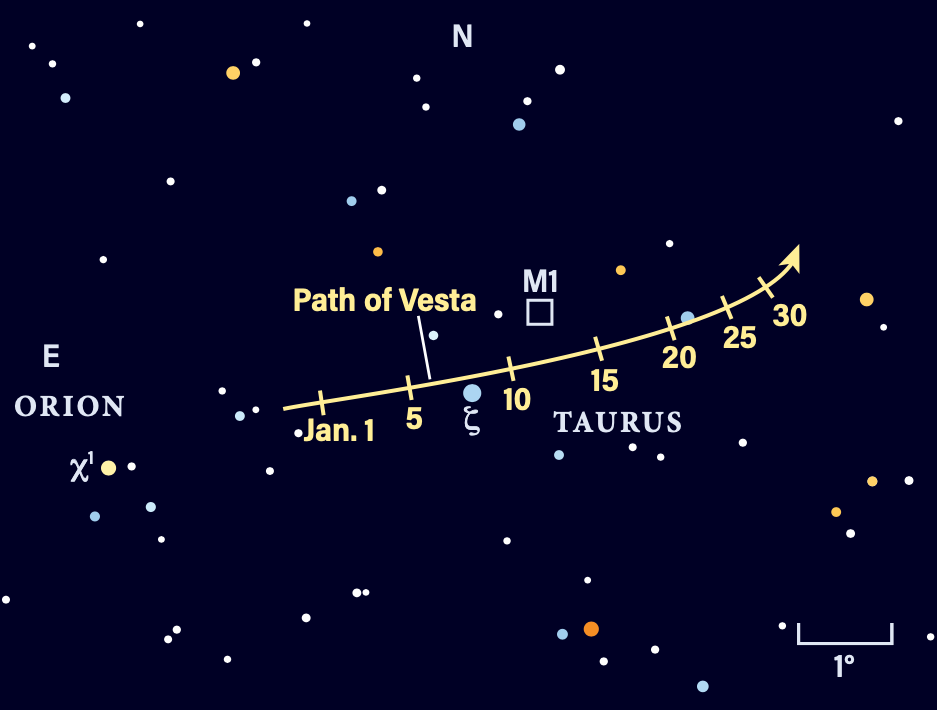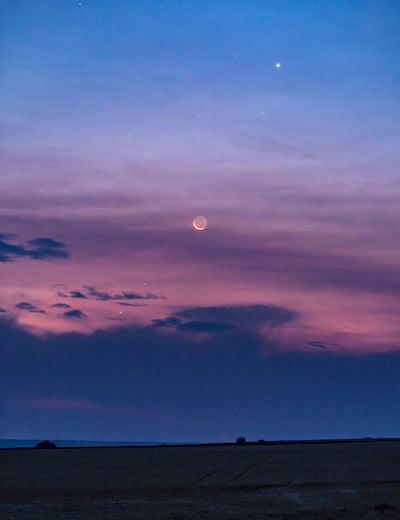
The new year begins with Jupiter and Saturn visible most of the evening. Uranus and Neptune are on show as well, requiring optical aid to spot. Meanwhile Mercury, Venus, and Mars congregate in the morning sky, with Mercury and Mars reaching a close conjunction. Also don’t miss the occultation of Antares, visible from portions of the mountain states and southern California. Add the potential for some binocular comets, and 2024 is off to a great start.
You’ll find Saturn glowing 30° high in the southwestern sky an hour after sunset. It lies in the constellation Aquarius, shining at magnitude 0.9. The bright star Fomalhaut — slightly fainter at magnitude 1.2 — lies 19° to its south-southeast. A beautiful thin crescent Moon stands 8° west and then 7° east of Saturn on the 13th and 14th, respectively.
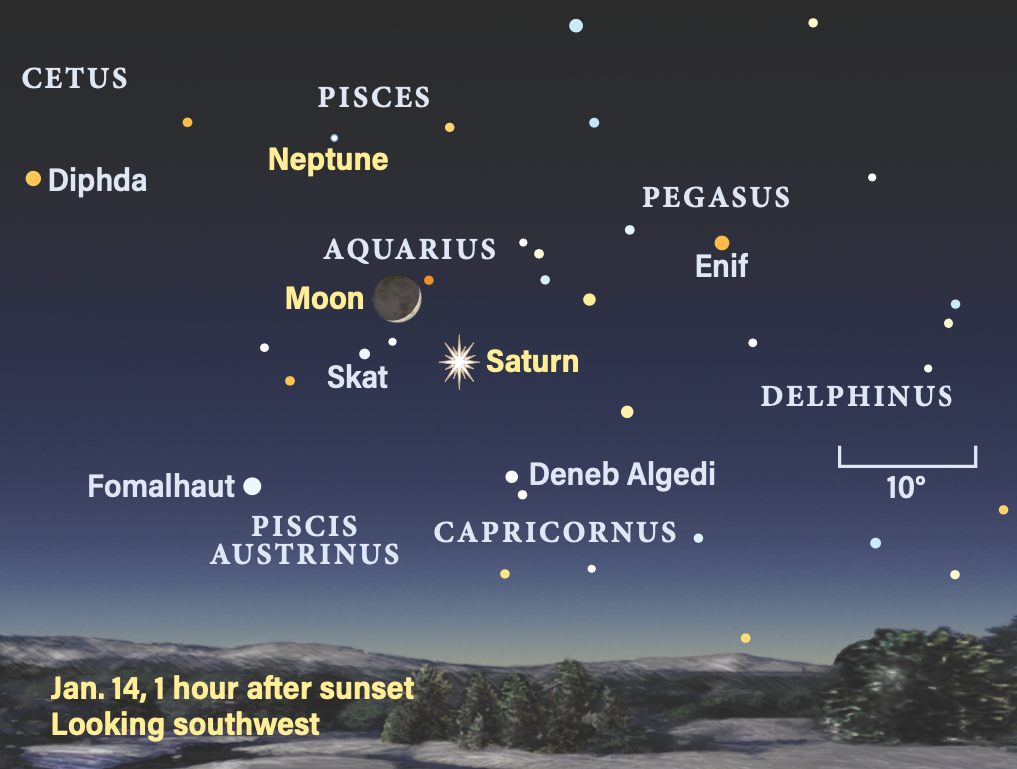
Catch Saturn through your telescope early in the evening before it gets too low. It sets by 9 p.m. local time on Jan. 1 and is gone before 7:30 p.m. on Jan. 31. Your best view of the narrowing rings will be as soon as you pick the planet up out of the darkening twilight. After an hour you will quickly lose Saturn in the haze.
Your scope will reveal the planet’s disk, spanning nearly 16″ on Jan. 1. It shaves off almost 1″ by Jan. 31, as the distance to Saturn increases. The rings are tilted by 9° to our line of sight, providing a stunning view.
Get your last views of Titan before the planet moves into conjunction with the Sun. You’ll find Saturn’s brightest moon shining at magnitude 8.8. It stands roughly north of the planet Jan. 13 and 29 and roughly south Jan. 5 and 21. Three more moons, easily spotted in small telescopes, flit around the planet inside the orbit of Titan. Tethys, Dione, and Rhea shine at magnitude 10. Their constantly changing locations are fascinating to follow from night to night.
Early on the evening of Jan. 10, observers might spot tiny Tethys transiting the disk of Saturn shortly after 7:20 p.m. CST. Its shadow follows about 15 minutes after the moon begins its transit. This transit is best observed from the Midwest to Pacific Coast. For the eastern half of the country, a second Tethys transit is visible early in the evening on Jan. 12, beginning just before 5:40 p.m. EST.
Iapetus reaches its fainter (near 12th magnitude) eastern elongation Jan. 6, when its darker hemisphere faces earthward. Its orbit carries it closer to Saturn until Jan. 26, when it reaches inferior conjunction 27″ north of the disk. It’s a great time to spot this enigmatic moon, which should be glowing near 11th magnitude.
Neptune stands about 20° east of Saturn along the ecliptic and sets soon after 8 p.m. local time at the end of January. It’s located in Pisces the Fish, just south of the Circlet asterism. It’s 5° due south of 4th-magnitude Lambda (λ) Piscium on Jan. 1. Binoculars will reveal the distant planet glowing at magnitude 7.8.
As an aid to finding Neptune, look for three 5th- and 6th-magnitude stars spanning nearly 3° in a line due east of Neptune’s location. As January progresses, Neptune wanders to within 1° of the easternmost star of the trio, 20 Psc. Another 7th-magnitude star lies 20′ south of Neptune.
The ice giant is some 30.6 astronomical units (2.8 billion miles; 1 astronomical unit, or AU, is the average Earth-Sun distance) from Earth in late January, and its tiny bluish disk spans 2″. Neptune’s retrograde motion ended in early December and the planet barely moves against the background stars all month.
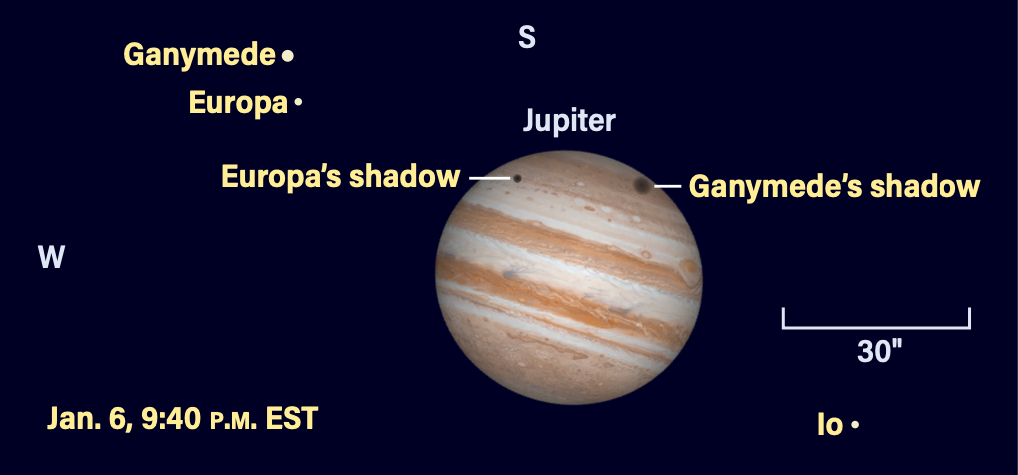
Jupiter is a stunning object all evening. After sunset, it stands high in the southern sky in Aries the Ram. It shines at magnitude –2.6 on Jan. 1 and dims to –2.4 by the 31st. Jupiter remains visible until after midnight, offering hours of viewing its delicate cloud belts and wandering moons. Its path through Aries is now directly eastward after reaching its stationary point at the end of December.
At the start of the month, Jupiter displays a magnificent disk spanning 4″ through a telescope.Immediately noticeable are two dark bands straddling the equator. Occasionally the Great Red Spot appears adjacent to the southern band. By the end of January, Jupiter’s distance from Earth has increased to 4.97 AU (462 million miles) and its disk spans 40″.
The four bright Galilean moons — Io, Europa, Ganymede, and Callisto — undergo transits and occultations. You’ll see moons transit first followed by their shadows, and as the month progresses, the separation between moon and shadow increases due to our changing perspective. Currently due to the relative tilt of its orbit to our line of sight, Callisto misses the disk.
On Jan. 6, Ganymede and Europa are transiting the disk at sunset in the Midwest. Their two shadows move across the planet next, starting with Europa’s around 7:40 p.m. EST. As it approaches the western limb of the planet, notice the giant black shadow of Ganymede begin to transit soon after 9:20 p.m. EST. It takes more than 10 minutes to fully appear. When do you first notice it? It slips onto the southern polar region of Jupiter and takes nearly two hours to cross the disk. Notice the two moons involved are now far west of the disk itself.
Europa and Ganymede repeat this event Jan. 13/14. By 8 p.m. EST, both moons are transiting. They leave the disk within about 15 minutes of each other starting at 9:45 p.m. EST. Later, both shadows appear to transit one after the other. They pair up again Jan. 20.
Overnight on Jan. 19/20, Callisto appears south of Jupiter at the same time that Io and its shadow are transiting the disk. For observers in the Midwest, Jupiter sets during the event — but the western half of the U.S. will see Callisto move due south of the planet.
Uranus shines at magnitude 5.7 and is located in eastern Aries, roughly halfway between Jupiter and the Pleiades star cluster (M45). It is an easy target to find with binoculars and technically visible to the naked eye under ideal conditions.
On Jan. 1, the ice giant stands 45′ south of 53 Arietis. It moves west during the month, extending this distance to 53′ by the time it reaches its stationary point Jan. 27. You can find this region about 12° southwest of M45, or roughly two field diameters in 7×50 binoculars. Uranus stands 19.5 AU (1.8 billion miles) from Earth by the end of the month and through a telescope shows off a 4″-wide disk.
The morning predawn sky hosts a trio of planets that quickly change relative position. Venus, the brightest and most obvious, rises early and is later joined by Mercury and Mars in the hour before sunrise, low in the southeast.
We’ll start with Venus, shining at magnitude –4 and standing less than 1° north of Beta (β) Scorpii on Jan. 1. Antares, the brightest star in Scorpius, lies 9° below Venus. The planet rises a full three hours before the Sun, placing it well up in the southeastern sky before twilight begins. On the same morning, Mercury stands 5° high an hour before sunrise and shines at magnitude 0.5. A telescope reveals Mercury as a 9″-wide disk that is nearly 30 percent lit.
Venus moves into Ophiuchus and stands 6° north of Antares by the 6th. A waning crescent Moon approaches the following morning, hanging 16° east of Venus. On the 8th, the Moon lies 6.6° south of Venus and occults Antares for a limited area of the U.S. Observers in a narrow band from southern California up through the Rocky Mountain states may see the occultation in twilight. The star disappears around 6:30 a.m. MST and reappears around 7:40 a.m. MST, in daylight for most of the U.S.
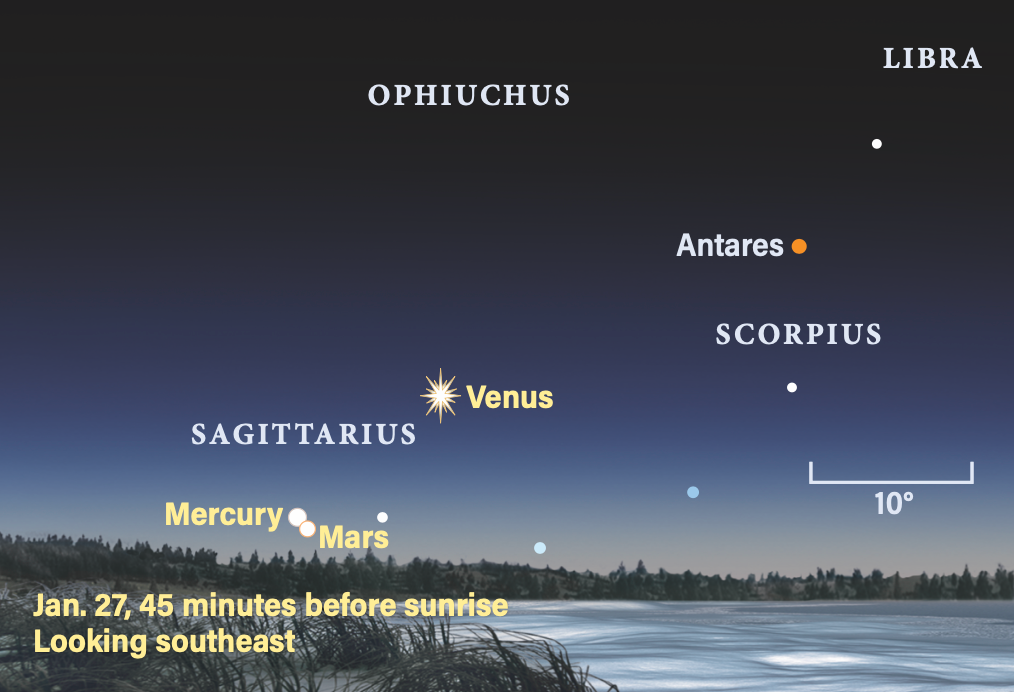
Meanwhile, Mercury reaches 51 percent lit on the 7th and brightens to magnitude –0.1 on the 8th. The apparent size of its disk has shrunk slightly (7″) as its orbit carries it away from Earth. The morning of Jan. 9 finds the waning Moon 7.5° south of Mercury. After the Moon departs the morning scene, Mercury and Venus move closer until the 17th, when they stand 11° apart. After this date, Mercury begins a slow fall back toward the Sun, extending its separation from Venus and brightening to magnitude –0.3 by the 31st.
Mars rises out of the Sun’s glow in late January. Your first opportunity to spot it could be Jan. 19, when Mars stands 5° east of Mercury. Forty-five minutes before sunrise, look for Mercury about 6° high in the southeast and shining at magnitude –0.2. Now search closer to the horizon for Mars, a very dim magnitude 1.3 and only 2° high. Binoculars will aid your search.
Mercury and Mars close in on each other until Jan. 27, when they stand a mere 15′ apart in twilight. You’ll need a telescope to spot Mars right next to Mercury — a rare and remarkable pairing. They stand 2° high 45 minutes before sunrise. As a guide, Venus is 12° farther west along the ecliptic and 10° above the horizon. Through a telescope, Mars appears full and 4″ wide, while Mercury shows an 84-percent-lit disk spanning 5″. Venus’ disk is 85 percent lit and 12″ across.
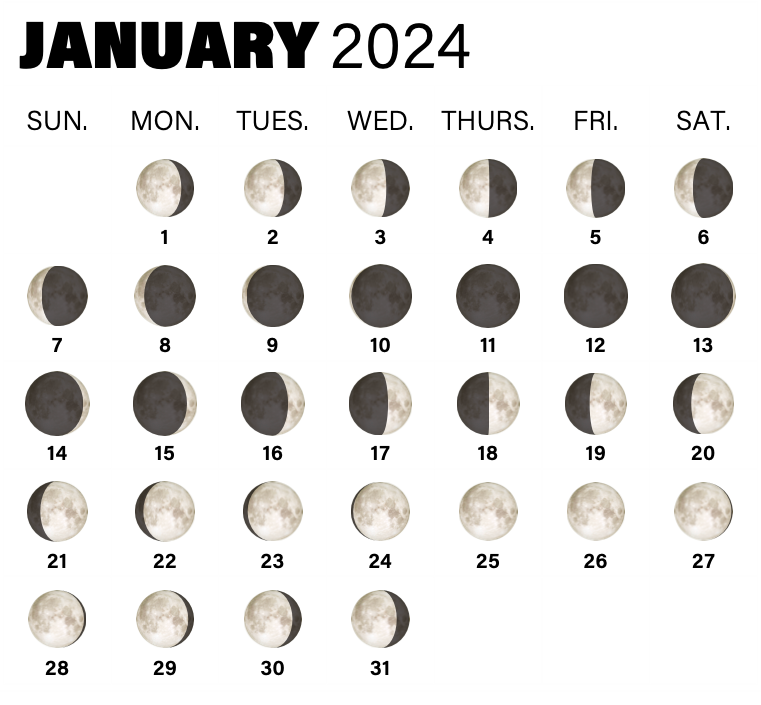
Rising Moon: Impacts disturb Tranquillity
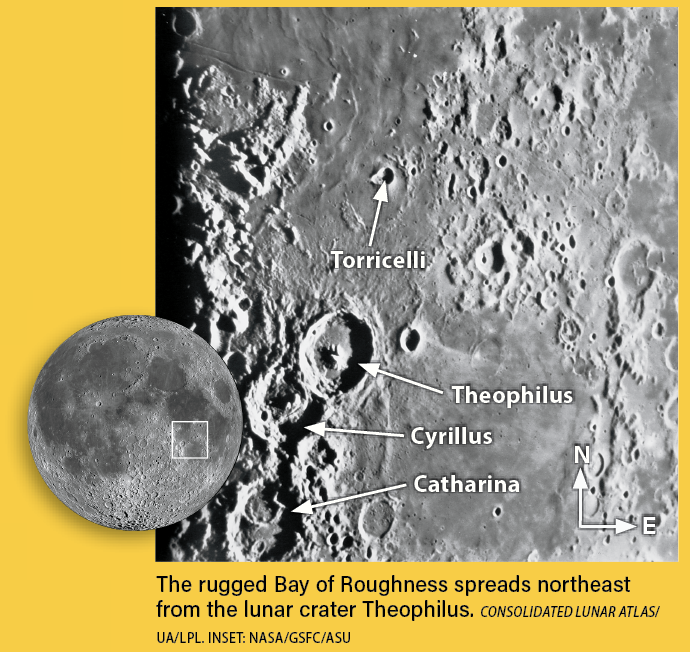
If there’s a best face to the Moon, the thick crescent phase is it. Then, its smooth seas seemingly sport large waves — big craters take your breath away and small impacts stand out by casting long shadows. On the evening of the 16th, the Serpentine Ridge is an attention-grabbing couplet of light and darkness snaking across the Sea of Serenity just north of the equator. Geologically it’s a compression feature, not a frozen wave rippling through the lava.
Scanning southward, you will run into Theophilus, a large 60-mile-wide, sharp-edged crater. Its complex jumble of peaks and multiple slumped terraces will have shorter shadows than in the scene pictured here. Cyrillus just to its south is about the same size but, being older, has softer edges. Catharina, offset more to the south, is older still, its lower and rounded rims evidence of a longer history of pummeling. The impact that created Theophilus spread such a rugged apron of debris northward onto the Sea of Tranquillity that the region is named Sinus Asperitatis, the Bay of Roughness.
Look closely at Torricelli, the unusual double crater north of Theophilus. Astronomers are confident that its weird shape comes from a single glancing blow instead of two unrelated events. A fraction of a second after impact, what was left of the projectile blasted through the back wall as the initial crater was in the process of forming. Torricelli itself sits off-center in a low-profile, ages-old battered bowl filled to the brim with lava.
Before inventing the mercury barometer, Evangelista Torricelli was an assistant to Galileo during the astronomer’s last months of life.
Meteor Watch: An early start
The Quadrantid meteor shower peaks the morning of Jan. 4 and is best viewed in the hours before dawn. The crescent Moon won’t affect observations much. The shower is active from Dec. 28 to Jan. 12; it is named after a defunct constellation that lies in the northern regions of Boötes.
The narrow peak of activity is expected to occur around 4 a.m. EST, favoring locations across the U.S. The radiant rises soon after 9 p.m. local time and by 4 a.m. is about 45° high. Expect about 25 to 30 meteors per hour, corresponding to a zenithal hourly rate of 80 meteors per hour (though this can vary quite a bit). Look also for the occasional fireball known to occur with this shower.
The Quadrantids result from 2003 EH1, discovered in 2003 by Brian Skiff at Lowell Observatory.
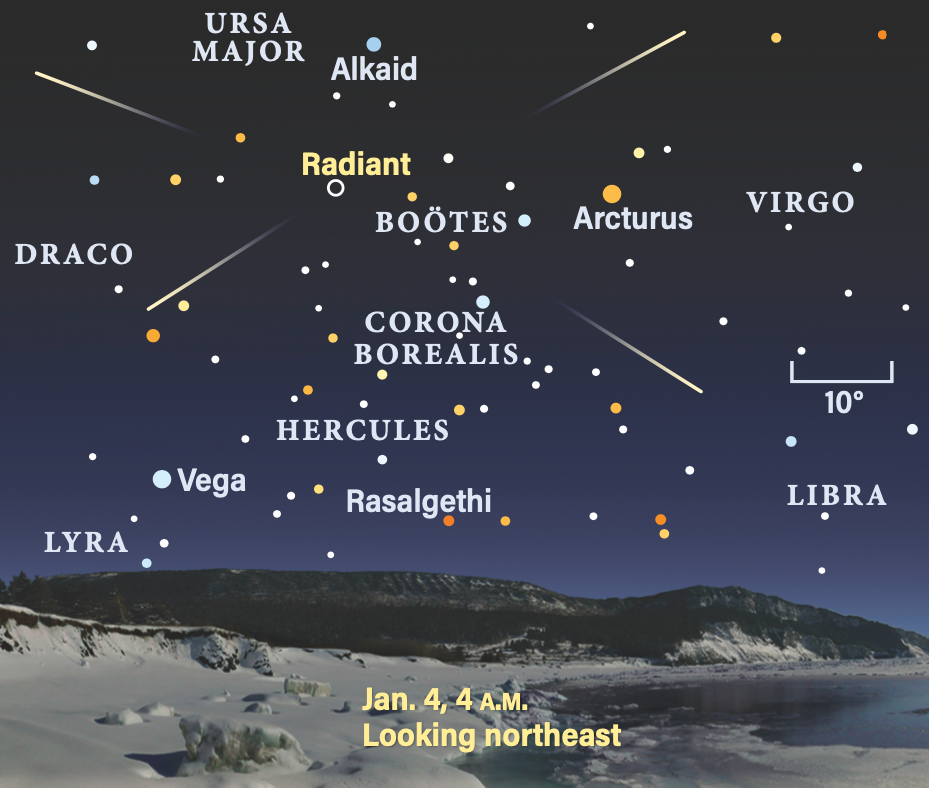
Comet Search: Climbing as the stars sink
Northwest, steady as she comes! By luck, the comet predicted to just crack the naked-eye barrier in April combines with Earth’s motion to remain between the evening ecliptic and the Milky Way. Comet 12P/Pons-Brooks only returns every 71 years, so few people alive will have seen it.
First discovered in 1812 by Jean-Louis Pons, it reached a respectable 4th magnitude. But its recorded positions were too poor to calculate its 1883 return, when it was accidentally recovered by William Brooks.
On the 12th, the 10th-magnitude fuzzball passes ½° from the Crescent Nebula (NGC 6888) in the picturesque heart of Cygnus. Set up in early twilight so you’re ready to observe before it drops below 10° in altitude. Put any city light dome to the southeast if you can.
An outburst to naked-eye brightness could happen! Comet researcher Richard Miles noted that Pons-Brooks can flare up more than 4 magnitudes in a night, and more than once per visit. Let’s hope the jump we saw in July repeats.
Meanwhile, 144P/Kushida approaches Aldebaran from the west, possibly breaking 9th magnitude (though some sources suggest only 11th). And observers south of the equator get a very nice view of 7th-magnitude C/2021 S3 (PanSTARRS) as dawn breaks. Observers in the Gulf States can join in, but this PanSTARRS discovery quickly gets difficult from farther north. The geometry improves next month.
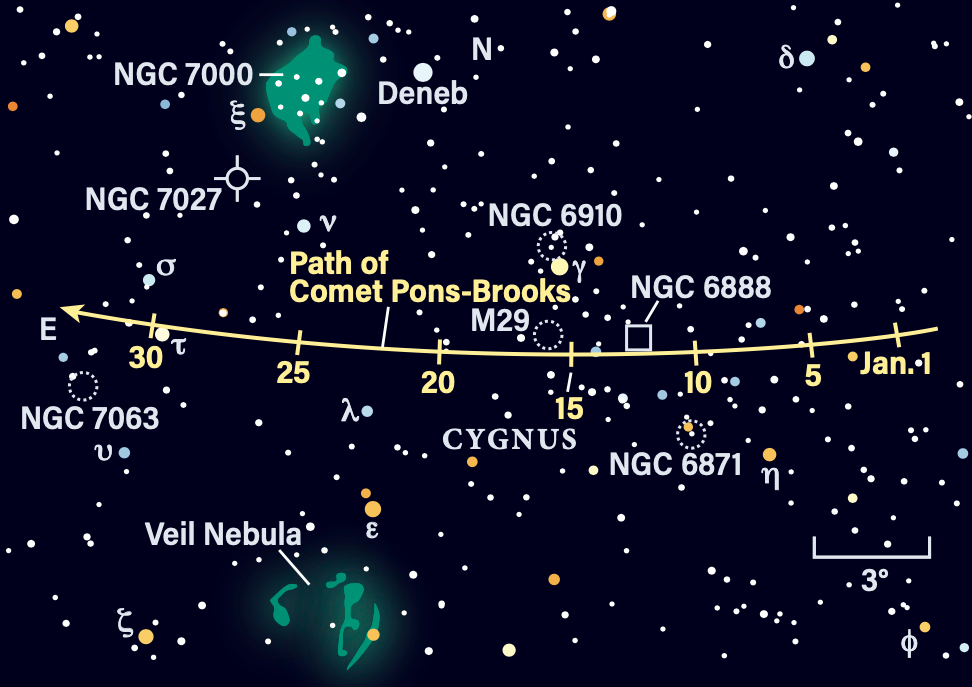
Locating Asteroids: Surf and turf
It should take less than five minutes to make a sighting of 4 Vesta. With 31 nights in January, how many times can you spot it?
Start at the orange luminary Aldebaran, the eye of Taurus, then slide east along the southern horn of the bull to reach 3rd-magnitude Zeta (ζ) Tauri. Vesta is remarkably easy for binoculars or the smallest scope from suburbia, making it simple to record its shifting position night to night on an observing log page. Despite the presence of the Milky Way, the Taurus dust clouds suppress so much background starlight that there are few stars 6th magnitude or brighter here.
Take note as our 7th-magnitude main-belt asteroid steps north of Zeta from the 7th to the 9th. In one session, you can even see it shift over the course of two to three hours. Jan. 10 is the best for that, while on the 21st, the Moon may interfere too much. From a dark sky, Vesta dots the low-power field of the Crab Nebula (M1) from Jan. 11 to 13.
Fans of seeing double can watch the rapid change in position angle for the very unequal pairing of 2nd-magnitude Beta (β) Tauri and 10th-magnitude asteroid 37 Fides, only 90″ to the star’s south, on the 3rd.
